Corymbia
| Corymbia | ||||||||||||
|---|---|---|---|---|---|---|---|---|---|---|---|---|
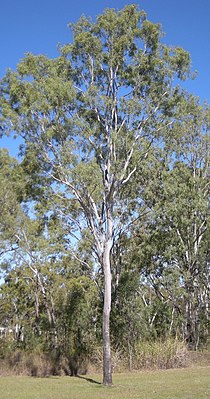
|
||||||||||||
| Systematics | ||||||||||||
|
||||||||||||
| Scientific name | ||||||||||||
| Corymbia | ||||||||||||
| KDHill & LASJohnson |
Corymbia is a genus of plants withinthe myrtle family (Myrtaceae). Almost all of the 95 to 115 species occur only in Australia ; only about five species occur in southern Papua New Guinea . English-language common names are " Bloodwood ", "Ghost Gum" or "Spotted Gum". Some species are used in many ways.
description




Appearance, bark and leaves
Corymbia species are evergreen and usually grow as trees , rarely in the growth form of the mallee - eucalyptus , this is a growth form that is more bush -shaped than tree-shaped , there are usually several trunks that form a lignotuber . They reach heights of growth of 5 to 40 meters.
The bark is smooth on the whole trunk or remains on the lower part of the trunk and is tessellated (brick-like structure). It is gray to gray-black, as well as matt, and on the upper parts of the trunk and the branches white, gray, creamy white to salmon-colored or orange-colored. There it peels in short ribbons or small, polygonal patches. There are oil glands in the bark and marrow .
Many species produce a red cinema in their wood and bark . That is why they are also called bloodwood or bloodwood.
At Corymbia is Heterophyllie ago. In some species the crown of the adult specimen contains juvenile leaves. In some species, the opposite to pseudo-opposite arranged leaves are twisted with the narrow side facing the sun on the branches. The mostly aromatic leaves are always divided into a petiole and a leaf blade. The petiole can be barely visible to long. The simple leaf blades are herbaceous or leathery, depending on the species. On young specimens the leaf blades are lanceolate to ovate and have stiff glandular hairs, sometimes only apparently none. On medium-old plants, the leaf blades are lanceolate to elliptical, straight, with entire margins and dull green. The leaf blades on adult specimens, which are equally dull gray-green on the underside and top of the leaves, are relatively thick, straight and narrow to broadly lanceolate or ovate with a blunt or pointed blade base and a pointed to rounded upper end. There is usually pinnate veining , but sometimes it looks like parallel veining or only one leaf vein can be seen; there are network veins between the side veins. The barely recognizable side veins go from the central vein at a small distance at an obtuse angle. On each half of the leaf there is a pronounced, continuous, so-called intramarginal vein, it runs at a small distance along the edge of the leaf. There are no stipules .
Inflorescences and flowers
Terminally or laterally on a pedunculate inflorescence stem stands a composite, little branched, paniculate or thyrsoid entire inflorescence , which consists of irregular, doldy partial inflorescences, each usually containing seven (three to eleven) flowers. There can be two bracts under each flower . The flower stalks are stalk-round.
The club-shaped flower bud is not floured or frosted blue-green. The hermaphrodite flowers are radial symmetry and four or five-fold with a double flower envelope . The free flower cup (hypanthium) is smooth. The four or five sepals form an outer calyptra or operculum that falls off early or is still present during anthesis . The smooth outer calyptra is kneecap-shaped or briefly conical and as wide as the flower cup. The four or five more or less free, mostly white or cream-colored, more rarely red ( Corymbia ficifolia ), entire-margined petals can be more or less fused with the sepals and can be fused to an inner calyptra, this can be at the same time or later than the outer Calyptra fall off. The many (20 to 150) mostly white or cream-colored, more rarely red ( Corymbia ficifolia ) stamens are mostly in some continuous circles and develop centripetally; they can all be the same or distinctly different. The stamens, which are regularly bent inward in the bud, are free from one another and not fused with the petals. The freely movable, dorsifix anthers are oblong or oblong-obovate and open with parallel slits. The anthers can have an appendage with a large gland. There is a discus . Except for its upper end, the ovary is covered by the flower cup. Usually three or four carpels are fused to form a semi-subordinate, mostly two-, three- or four- chamber ovary. The stalked ovary contains many (20 to 50) ascending, hemi-anatropic ovules in a central-angled placentation . The stylus is upright and curved in the bud. The scars have short or long papillae .
Fruits and seeds
The stalked capsule fruits are cylindrical, ovoid, spherical or urn-shaped and lignified in most species; they open at maturity. The disc is pressed in and the three to four fruit compartments are included.
The kneecap-shaped or egg-shaped seeds are regular or flattened with a slightly reticulated and matt to silk-matt, red or red-brown seed coat (testa). There is a hilum at the top of the seed . The winged or wingless seed does not contain an endosperm . The embryo has two kidney-shaped cotyledons ( cotyledons ).
ecology
The pollination is done by insects ( Entomophilie ) or birds ( ornithophily ).
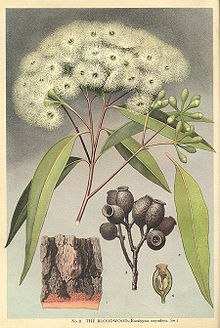

Systematics
The genus Corymbia was founded in 1995 by Kenneth D. Hill and Lawrence Alexander Sidney Johnson in Systematic studies in the eucalypts. 7. A revision of the bloodwoods, genus Corymbia (Myrtaceae). In: Telopea , Volume 6, Issue 2–3, page 214. Type species is Corymbia gummifera (Gaertn.) KDHill & LASJohnson . Synonyms for Corymbia K.D. Hill & LASJohnson are: Eucalyptus ser. Corymbosae Blakely and Eucalyptus subser. Corymbosae Benth.
The genus Corymbia belongs to the tribe Eucalypteae in the subfamily Myrtoideae within the family Myrtaceae .
Botanical history
Eucalyptus subser. Corymbosae Benth. was already viewed by Bentham in 1867 as a separate group in the large and widely branched genus Eucalyptus . William Faris Blakely in A Key to the Eucalypts , 15, 1934, page 73 classified this kindred as the series Eucalyptus ser. Corymbosae Blakely of the genus Eucalyptus . Molecular genetic studies in the 1990s showed that these species are more related to the Angophora species than to the core group of the genus Eucalyptus and are therefore better viewed as a separate genus. It was not until 1995 that they were introduced by Ken Hill and Lawrie Johnson in Systematic studies in the eucalypts. 7. A revision of the bloodwoods, genus Corymbia (Myrtaceae). In: Telopea , Volume 6, Issue 2-3, pages 185-504 placed in the rank of a genus Corymbia . Another synonym for Corymbia K.D. Hill & LASJohnson is Eucalyptus subg. Corymbia (KDHill & LASJohnson) Brooker (in Murray Ian Hill Brooker: A new classification of the genus Eucalyptus L'Her. (Myrtaceae). In: Australian Systematic Botany , volume 13, Issue 1, 2000, p. 85).
All three genera of the eucalyptus s. l. - Eucalyptus , Corymbia and Angophora - are closely related, often difficult to distinguish and are still grouped under the term eucalyptus . Since Hill and Johnson established the genus Corymbia in 1995, there has been ongoing research into the relationship between the three genera. Genetic analyzes of the ETS and Spacer sections of DNA, carried out in 2006 by Carlos Alberto Parra Osorio and colleagues on 67 taxa (47 of them in the genus Corymbia ), showed that Corymbia and Angophora are most closely related, and Eucalyptus is one represents previously split off genus. In Parra Osorio, Carlos Alberto & Michael Bayly: ETS sequences support the monophyly of the eucalypt genus Corymbia (Myrtaceae). In: Taxon , Volume 55, No. 3, 2006, pp. 653-663, it was discussed that the small genera Eucalyptopsis , Stockwellia and Allosyncarpia form their own family group that split off even earlier. In 2009 Osorio et al. added further taxa and published a combined analysis of the cell rDNA (ETS + spacer) and the morphological features in order to clarify the relationships within the genera. Thus two main kin groups were confirmed, which they defined as subgenus of Corymbia : Corymbia and Blakella .
Differentiation of closely related genera
Corymbia are defined as eucalyptuses that have umbrella-like (English corymb ) inflorescences . These inflorescences appear like compound umbels , but have elongated pedicels at the edge , which lead to a flat surface formation of the inflorescence. The genus Angophora is much more difficult to distinguish from the genus Eucalyptus . The most important distinguishing feature is the position of the leaves on the branch of the fully grown plant specimens: While the Angophora have opposite leaves, this does not apply to most species of the genus Eucalyptus . However, the younger specimens of these species often have the leaf arrangement of the Angophora .
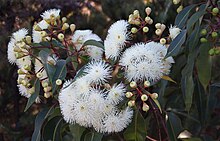



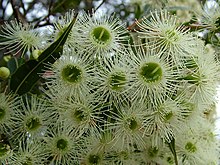







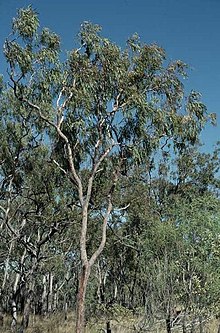

Species and their distribution
Corymbia species occur mainly in the northern half of Australia, but also in the southwest of Western Australia and on the east coast of the continent, down to eastern Victoria . Some species are also found on the south coast of Papua New Guinea .
There are around 95 (up to 127) species of Corymbia :
- Corymbia abbreviata (Blakely & Jacobs) KDHill & LASJohnson : It occurs in Western Australia and the Northern Territory .
- Corymbia abergiana (F.Muell.) KDHill & LASJohnson : It occurs only in the Australian state of Queensland .
- Corymbia aparrerinja K.D. Hill & LASJohnson (Syn .: Corymbia punkapitiensis K.D. Hill & LASJohnson ): It occurs in Western Australia, Queensland and the Northern Territory.
- Corymbia arafurica K.D. Hill & LASJohnson : It is only found in the Australian Northern Territory.
- Corymbia arenaria (Blakely) KDHill & LASJohnson : It is only found in the Australian state of Western Australia.
- Corymbia arnhemensis (DJCarr & SGMCarr) KDHill & LASJohnson : It occurs only in the Australian Northern Territory.
- Corymbia aspera (F.Muell.) KDHill & LASJohnson : It occurs in Western Australia, Queensland and the Northern Territory.
- Corymbia aureola (Brooker & ARBean) KDHill & LASJohnson : It is only found in the Australian state of Queensland.
- Corymbia bella K.D. Hill & LASJohnson : It occurs in Western Australia, Queensland and the Northern Territory.
- Corymbia blakei K.D. Hill & LASJohnson (Syn .: Corymbia inobvia K.D. Hill & LASJohnson , Corymbia blakei subsp. Rasilis K.D. Hill & LASJohnson ): It occurs only in the Australian state of Queensland.
- Corymbia bleeseri (Blakely) KDHill & LASJohnson : It occurs in Western Australia and the Northern Territory.
- Corymbia bloxsomei (Maiden) KDHill & LASJohnson : It is only found in the Australian state of Queensland.
- Corymbia brachycarpa (DJCarr & SGMCarr) KDHill & LASJohnson : It is only found in the Australian state of Queensland.
- Corymbia bunites (Brooker & ARBean) KDHill & LASJohnson : It is only found in the Australian state of Queensland.
- Corymbia cadophora K.D. Hill & LASJohnson : The three subspecies are only found in the Australian state of Western Australia.
- Marri tree ( Corymbia calophylla (R.Br. ex Lindl.) KDHill & LASJohnson ): It occurs in Western Australia and South Australia (perhaps only naturalized there).
- Corymbia candida K.D. Hill & LASJohnson : It occurs in Western Australia and the Northern Territory.
- Corymbia chartacea K.D. Hill & LASJohnson : It occurs only in the Australian Northern Territory.
- Corymbia × chillagoensis K.D. Hill & LASJohnson : This natural hybrid is only found in the Australian state of Queensland.
- Corymbia chippendalei (DJCarr & SGMCarr) KDHill & LASJohnson : It occurs in Western Australia and the Northern Territory.
- Lemon eucalyptus ( Corymbia citriodora (Hook.) KDHill & LASJohnson , Corymbia variegata (F.Muell.) KDHill & LASJohnson , Corymbia citriodora subsp. Variegata (F.Muell.) ARBean & MWMcDonald ): It occurs in some areas of Queensland and New Southeast Wales, of course, and is naturalized there in other areas. In Western Australia, South Australia and Victoria it is a neophyte .
- Corymbia clandestina (ARBean) KDHill & LASJohnson : It occurs only in the Australian state of Queensland.
- Corymbia clarksoniana (DJCarr & SGMCarr) KDHill & LASJohnson (Syn .: Corymbia dolichocarpa (DJCarr & SGMCarr) KDHill & LASJohnson , Corymbia maritima K.D.Hill & LASJohnson , Corymbia hooligans subsp. Burdekinensis K.D.Hill & LASJohnson ): It comes in the Australian states of Queensland as well as New South Wales.
- Corymbia clavigera (A.Cunn. Ex Schauer) KDHill & LASJohnson : It occurs only in the Australian state of Western Australia.
- Corymbia cliftoniana (W.Fitzg.) KDHill & LASJohnson : It occurs in Western Australia and the Northern Territory.
- Corymbia collina (W.Fitzg.) KDHill & LASJohnson : It occurs only in the Australian state of Western Australia.
- Corymbia confertiflora (Kippist ex F.Muell.) KDHill & LASJohnson : It occurs in Western Australia, Queensland and the Northern Territory.
- Corymbia dallachiana (Benth.) KDHill & LASJohnson : It is only found in the Australian state of Queensland.
- Corymbia dendromerinx K.D. Hill & LASJohnson : It is only found in the Australian state of Western Australia.
- Corymbia deserticola (SGMCarr) KDHill & LASJohnson : The two subspecies occur in the Australian Western Australia and Northern Territory.
- Corymbia dichromophloia (F.Muell.) KDHill & LASJohnson (Syn .: Corymbia rubens K.D. Hill & LASJohnson , Corymbia capricornia (DJCarr & SGMCarr) KDHill & LASJohnson ): It occurs in Western Australia, Queensland and Northern Territory.
- Corymbia disjuncta K.D. Hill & LASJohnson (Syn .: Corymbia karelgica K.D. Hill & LASJohnson ): It occurs in Western Australia, Queensland and the Northern Territory.
- Corymbia dunlopiana K.D. Hill & LASJohnson : It is only found in the Australian Northern Territory.
- Corymbia ellipsoidea (DJCarr & SGMCarr) KDHill & LASJohnson (Syn .: Corymbia porphyritica K.D. Hill & LASJohnson ): It occurs only in the Australian state of Queensland.
- Corymbia eremaea (DJCarr & SGMCarr) KDHill & LASJohnson (Syn .: Corymbia eremaea subsp. Oligocarpa (Blakely & Jacobs) KDHill & LASJohnson ): It occurs in Western Australia, Queensland and the Northern Territory.
- Corymbia erythrophloia (Blakely) KDHill & LASJohnson : It is only found in the Australian state of Queensland.
- Corymbia eximia (Schauer) KDHill & LASJohnson : It occurs only in the Australian state of New South Wales .
- Corymbia ferriticola (Brooker & Edgecombe) KDHill & LASJohnson (Syn .: Corymbia ferriticola subsp. Sitiens (Schauer) KDHill & LASJohnson ): It occurs only in the Australian state of Western Australia.
- Corymbia ferruginea (shower) KDHill & LASJohnson : The two subspecies occur in Western Australia, Queensland and the Northern Territory.
- Corymbia ficifolia (F.Muell.) KDHill & LASJohnson : It occurs in Western Australia and South Australia (perhaps only naturalized there).
- Corymbia flavescens K.D. Hill & LASJohnson : It occurs in Western Australia, Queensland and the Northern Territory.
- Corymbia foelscheana (F.Muell.) KDHill & LASJohnson : It occurs in Western Australia and the Northern Territory.
- Corymbia gilbertensis (Maiden & Blakely) KDHill & LASJohnson : It is only found in the Australian state of Queensland.
- Corymbia grandifolia (R.Br. ex Benth.) KDHill & LASJohnson : The three subspecies occur in Western Australia, Queensland and the Northern Territory.
- Corymbia greeniana (DJCarr & SGMCarr) KDHill & LASJohnson (Syn .: Corymbia curtipes (DJCarr & SGMCarr) KDHill & LASJohnson , Corymbia byrnesii (DJCarr & SGMCarr) KDHill & LASJohnson ): It occurs in the Australian Western Australia, Queensland.
- Corymbia gummifera (Gaertn.) KDHill & LASJohnson : It occurs in the Australian states of New South Wales, Queensland and Victoria.
- Corymbia haematoxylon (Maiden) KDHill & LASJohnson : It is only found in the Australian state of Western Australia.
- Corymbia hamersleyana (DJCarr & SGMCarr) KDHill & LASJohnson (Syn .: Corymbia semiclara K.D. Hill & LASJohnson ): It occurs only in the Australian state of Western Australia.
- Corymbia hendersonii K.D. Hill & LASJohnson : It is only found in the Australian state of Queensland.
- Corymbia henryi (STBlake) KDHill & LASJohnson : It occurs in the Australian states of New South Wales and Queensland.
- Corymbia hylandii (DJCarr & SGMCarr) KDHill & LASJohnson : It is only found in the Australian state of Queensland.
- Corymbia intermedia (F.Muell. Ex RTBaker) KDHill & LASJohnson : It occurs in the Australian states of New South Wales and Queensland.
- Corymbia jacobsiana (Blakely) KDHill & LASJohnson : It is only found in the Australian Northern Territory.
- Corymbia kombolgiensis (Brooker & Dunlop) KDHill & LASJohnson : It occurs only in the Australian Northern Territory.
- Corymbia lamprophylla (Brooker & ARBean) KDHill & LASJohnson : It is only found in the Australian state of Queensland.
- Corymbia latifolia (F.Muell.) KDHill & LASJohnson : It occurs in Western Australia, Queensland and the Northern Territory.
- Corymbia leichhardtii (FMBailey) KDHill & LASJohnson : It occurs only in the Australian state of Queensland.
- Corymbia lenziana (DJCarr & SGMCarr) KDHill & LASJohnson : It occurs in South Australia, Western Australia and Northern Territory.
- Corymbia leptoloma (Brooker & ARBean) KDHill & LASJohnson : It is only found in the Australian state of Queensland.
- Corymbia ligans K.D. Hill & LASJohnson : It is only found in the Australian state of Queensland.
- Corymbia maculata (Hook.) KDHill & LASJohnson : It occurs naturally only in Victoria in some areas, in other parts of this state it is naturalized. In South Australia and Western Australia it is probably a neophyte.
- Corymbia nesophila (Blakely) KDHill & LASJohnson : It occurs in Western Australia, Queensland and the Northern Territory.
- Corymbia novoguinensis (DJCarr & SGMCarr) KDHill & LASJohnson : It occurs only in the Australian state of Queensland. It occurs on some islands of the Torres Strait, in Papua New Guinea and in West Papua.
- Corymbia oocarpa (DJCarr & SGMCarr) KDHill & LASJohnson : It is only found in the Australian Northern Territory.
- Corymbia opaca (DJCarr & SGMCarr) KDHill & LASJohnson : It occurs in Western Australia, South Australia and the Northern Territory.
- Corymbia × opacula L.ASJohnson : It occurs only in the Australian state of Western Australia.
- Corymbia pachycarpa K.D. Hill & LASJohnson (Syn .: Corymbia pachycarpa subsp. Glabrescens K.D. Hill & LASJohnson ): It occurs in Western Australia and the Northern Territory.
- Corymbia papillosa K.D. Hill & LASJohnson (Syn .: Corymbia papillosa subsp. Globifera K.D. Hill & LASJohnson ): It occurs in Western Australia and the Northern Territory.
- Corymbia papuana (F.Muell.) KDHill & LASJohnson (Syn .: Corymbia paracolpica K.D. Hill & LASJohnson ): It occurs in southern Papua New Guinea, southern West Papua, on the islands of the Torres Strait and on the northern part of the Cape York Peninsula , which belongs to Queensland.
- Corymbia paractia K.D. Hill & LASJohnson : It occurs only in the Australian state of Western Australia.
- Corymbia paractia K.D. Hill & LASJohnson : It occurs only in the Australian state of Western Australia.
- Corymbia pauciseta K.D. Hill & LASJohnson : It is only found in the Australian Northern Territory.
- Corymbia × pedimontana L.ASJohnson : It is only found in the Australian state of Western Australia.
- Corymbia peltata (Benth.) KDHill & LASJohnson (Syn .: Corymbia dimorpha (Brooker & ARBean) KDHill & LASJohnson ): It occurs only in the Australian state of Queensland.
- Corymbia petalophylla (Brooker & ARBean) KDHill & LASJohnson : It is only found in the Australian state of Queensland.
- Corymbia plena K.D. Hill & LASJohnson : It is only found in the Australian state of Queensland.
- Corymbia pocillum (DJCarr & SGMCarr) KDHill & LASJohnson : It is only found in the Australian state of Queensland.
- Corymbia polycarpa (F.Muell.) KDHill & LASJohnson : It occurs in Western Australia, Queensland and the Northern Territory.
- Corymbia polysciada (F.Muell.) KDHill & LASJohnson : It occurs only in the Australian Northern Territory.
- Corymbia porrecta (STBlake) KDHill & LASJohnson : It occurs only in the Australian Northern Territory.
- Corymbia ptychocarpa (F.Muell.) KDHill & LASJohnson : The two subspecies occur in Western Australia, Queensland and Northern Territory.
- Corymbia rhodops (DJCarr & SGMCarr) KDHill & LASJohnson : It is only found in the Australian state of Queensland.
- Corymbia scabrida (Brooker & ARBean) KDHill & LASJohnson : It occurs only in the Australian state of Queensland.
- Corymbia serendipita (Brooker & Kleinig) ARBean (Syn .: Corymbia arnhemensis subsp. Monticola K.D. Hill & LASJohnson ): This new combination took place in 2002. It occurs only in the Australian state of Queensland.
- Corymbia setosa (Schauer) KDHill & LASJohnson (Syn .: Corymbia setosa subsp. Pedicellaris K.D. Hill & LASJohnson ): It occurs in the Australian Queensland and Northern Territory.
- Corymbia sphaerica K.D. Hill & LASJohnson : It is only found in the Australian Northern Territory.
- Corymbia stockeri (DJCarr & SGMCarr) KDHill & LASJohnson : The two subspecies are only found in the Australian state of Queensland.
- Corymbia terminalis (F.Muell.) KDHill & LASJohnson (Syn .: Corymbia tumescens K.D. Hill & LASJohnson ): It occurs in Western Australia, South Australia, Queensland and the Northern Territory.
- Corymbia tessellaris (F.Muell.) KDHill & LASJohnson : It occurs in the Australian states of New South Wales and Queensland.
- Corymbia torelliana (F.Muell.) KDHill & LASJohnson : It occurs only in the Australian state of Queensland.
- Corymbia torta K.D. Hill & LASJohnson : It is only found in the Australian state of Western Australia.
- Corymbia Trachyphloia (F.Muell.) KDHill & LASJohnson (Syn .: Corymbia Trachyphloia subsp. Carnarvonica K.D.Hill & LASJohnson , Corymbia Trachyphloia subsp. Amphistomatica K.D.Hill & LASJohnson ): It occurs in the Australian states of New South Wales and Queensland.
- Corymbia umbonata (DJCarr & SGMCarr) KDHill & LASJohnson : It is only found in the Australian Northern Territory.
- Corymbia watsoniana (F.Muell.) KDHill & LASJohnson : The two subspecies occur only in the Australian state of Queensland.
- Corymbia xanthope (ARBean & Brooker) KDHill & LASJohnson : It is only found in the Australian state of Queensland.
- Corymbia zygophylla (Blakely) KDHill & LASJohnson : It is only found in the Australian state of Western Australia.

use
Some Corymbia species are used as ornamental plants . Examples are: Corymbia aparrerinja , Corymbia calophylla , Corymbia citriodora (This tall tree is known for the beauty of its white or light gray trunk; immediately recognizable by the strong lemon scent of the leaves), Corymbia ficifolia , Corymbia maculata (it has a bark with peculiar, irregular round patches that can take on different colors, from beige to blue-gray to orange, pink or red), Corymbia ptychocarpa and Corymbia torelliana . There are varieties of some species.
The wood of some types of Corymbia , which is considered to be very hard, is processed in industry and craft:
- Spotted Gum ( Corymbia citriodora , Corymbia henryi and Corymbia maculata ): Their heartwood is light brown to dark red-brown and has a specific weight of around 1010 kg / m³. It is used as construction and furniture wood and is used, for example, in boat building and for the manufacture of tool handles, railway sleepers and floors.
- Red Bloodwood ( Corymbia gummifera , Corymbia intermedia and Corymbia polycarpa ): The color of the heartwood varies from old pink to deep red to reddish brown and its specific weight is around 1010 kg / m³. It is used, for example, to manufacture beams, railway sleepers, hardboard and fences
- Carbeen ( Corymbia tessellaris ): Their heartwood is medium to dark brown and has a specific weight of about 1040 kg / m³. It is used as construction and furniture wood and is used, for example, in car construction and for the production of railway sleepers, floors, cladding and fences.
swell
literature
- Ken Hill , Lawrie Johnson : Systematic studies in the eucalypts. 7. A revision of the bloodwoods, genus Corymbia (Myrtaceae). In: Telopea , Volume 6, Issue 2-3, pp. 185–504.
- Carlos Parra Osorio, Michael Bayly, Frank Udovicic, Pauline Ladiges: ETS sequences support the monophyly of the eucalypt genus Corymbia (Myrtaceae). In: Taxon , Volume 55, Issue 3, 2006, pages 653-663. JSTOR 25065641
- Carlos Parra Osorio, Michael Bayly, A. Drinnan, Frank Udovicic, Pauline Ladiges: Phylogeny, major clades and infrageneric classification of Corymbia (Myrtaceae), based on nuclear ribosomal DNA and morphology. In: Australian Systematic Botany , Volume 22, Issue 5, 2009, pp. 384-399. doi : 10.1071 / SB09028
Individual evidence
- ↑ a b Specimen search results: Corymbia at Australia's Virtual Herbarium. Council of Heads of Australasian Herbaria . last accessed on February 1, 2013
- ↑ a b c d e f g h i j k K. Hill: Genus Corymbia at New South Wales Flora Online . National Herbarium of NSW, Royal Botanic Garden, Sydney. last accessed on February 28, 2013
- ↑ a b c d e f g h i j k l m n o p q r s t u v w x Corymbia at the Western Australian Flora . last accessed on February 1, 2013
- ↑ a b c d e f g h i j k Corymbia at EucaLink - A Web Guide to the Eucalypts . last accessed on February 1, 2013
- ↑ a b c d e f g h i j k l m n o p q r s t u v w x y z aa ab ac ad ae af ag ah ai aj ak al am an ao ap aq ar as at au av aw ax ay az ba bb bc bd be bf bg bh bi bj bk bl bm bn bo bp bq br bs bt bu bv bw bx by bz ca cb cc cd ce cf cg ch ci cj ck cl cm cn co cp cq cr cs ct cu cv entry at Australian Plant Name Index = APNI. last accessed on May 2, 2020
- ^ Corymbia at Tropicos.org. Missouri Botanical Garden, St. Louis, accessed December 28, 2012.
- ^ A b Corymbia in the Germplasm Resources Information Network (GRIN), USDA , ARS , National Genetic Resources Program. National Germplasm Resources Laboratory, Beltsville, Maryland. Retrieved December 28, 2012.
- ↑ Carlos Alberto Parra Osorio, Michael Bayly, Andrew Drinnen, Frank Udovicic, Pauline Ladiges: Phylogeny, major clades an infrageeric classification of Corymbia (Myrtaceae), based on nuclear ribosomal DNA and morphology. In: Australian Systematic Botany , Volume 22, Issue 5, 2009, pp. 384-399: Online.
- ↑ Rafaël Govaerts (ed.): Corymbia. In: World Checklist of Selected Plant Families (WCSP) - The Board of Trustees of the Royal Botanic Gardens, Kew . Retrieved December 28, 2012.
- ↑ Gordon Cheers (Ed.): Botanica. The ABC of plants. 10,000 species in text and images . Könemann Verlagsgesellschaft, 2003, ISBN 3-8331-1600-5 (therein pages 256-257).
- ↑ Spotted Gum . Department of Agriculture, Fisheries and Forestry. Queensland Government. last accessed on February 10, 2016
- ↑ Red Bloodwood . Department of Agriculture, Fisheries and Forestry. Queensland Government ( Memento of the original from March 7, 2013 in the Internet Archive ) Info: The archive link was inserted automatically and has not yet been checked. Please check the original and archive link according to the instructions and then remove this notice. . last accessed on February 4, 2013
- ↑ Carbeen . Department of Agriculture, Fisheries and Forestry. Queensland Government ( Memento of the original from March 7, 2013 in the Internet Archive ) Info: The archive link was inserted automatically and has not yet been checked. Please check the original and archive link according to the instructions and then remove this notice. . last accessed on February 4, 2013
Web links
- Jim Barrow: Corymbia, Corymbia…. wherefore art thou Corymbia? . Australian Plants Online , May 2000.
- Timber Advisory Notes - Timbers grown in Australia by Department of Agriculture and Food - Government of Western Australia .
- Red bloodwood = Corymbia gummifera; C. intermedia; C. polycarpa. Family: Myrtaceae , Spotted gum = Corymbia citriodora subsp. variegata, C. citriodora subsp. citriodora, C. maculata, C. henryi. Family: Myrtaceae at Wood properties and uses of Australian timbers - The State of Queensland (Department of Agriculture, Fisheries and Forestry) .
- A brief history of Eucalyptus , Angophora and Corymbia . (online) In: Euclid: Center for Australian National Biodiversity Research. AV Slee, Murray Ian Hill Brooker Brooker, SM Duffy, JG West, 2015, accessed May 3, 2020 (English, Edition 4).


